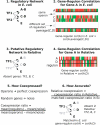Orthologous transcription factors in bacteria have different functions and regulate different genes
- PMID: 17845071
- PMCID: PMC1971122
- DOI: 10.1371/journal.pcbi.0030175
Orthologous transcription factors in bacteria have different functions and regulate different genes
Abstract
Transcription factors (TFs) form large paralogous gene families and have complex evolutionary histories. Here, we ask whether putative orthologs of TFs, from bidirectional best BLAST hits (BBHs), are evolutionary orthologs with conserved functions. We show that BBHs of TFs from distantly related bacteria are usually not evolutionary orthologs. Furthermore, the false orthologs usually respond to different signals and regulate distinct pathways, while the few BBHs that are evolutionary orthologs do have conserved functions. To test the conservation of regulatory interactions, we analyze expression patterns. We find that regulatory relationships between TFs and their regulated genes are usually not conserved for BBHs in Escherichia coli K12 and Bacillus subtilis. Even in the much more closely related bacteria Vibrio cholerae and Shewanella oneidensis MR-1, predicting regulation from E. coli BBHs has high error rates. Using gene-regulon correlations, we identify genes whose expression pattern differs between E. coli and S. oneidensis. Using literature searches and sequence analysis, we show that these changes in expression patterns reflect changes in gene regulation, even for evolutionary orthologs. We conclude that the evolution of bacterial regulation should be analyzed with phylogenetic trees, rather than BBHs, and that bacterial regulatory networks evolve more rapidly than previously thought.
Conflict of interest statement
Figures





References
-
- Guédon E, Jamet E, Renault P. Gene regulation in Lactococcus lactis: The gap between predicted and characterized regulators. Antonie van Leeuwenhoek. 2002;82:93–112. - PubMed
-
- Gelfand MS. Evolution of transcriptional regulatory networks in microbial genomes. Curr Opin Struct Biol. 2006;16:420–429. - PubMed
-
- Babu MM, Teichmann SA, Aravind L. Evolutionary dynamics of prokaryotic transcriptional regulatory networks. J Mol Biol. 2006;358:614–633. - PubMed
Publication types
MeSH terms
Substances
LinkOut - more resources
Full Text Sources
Other Literature Sources
Research Materials

